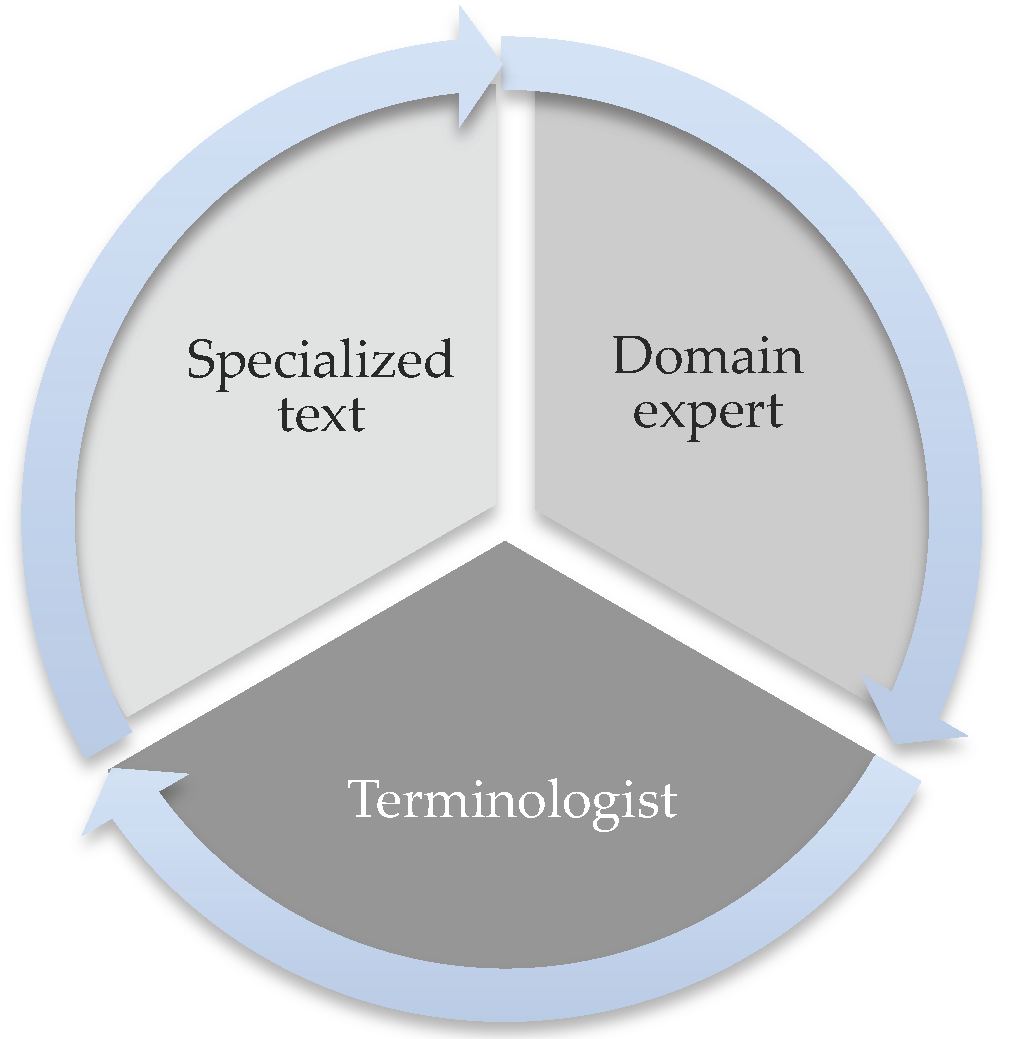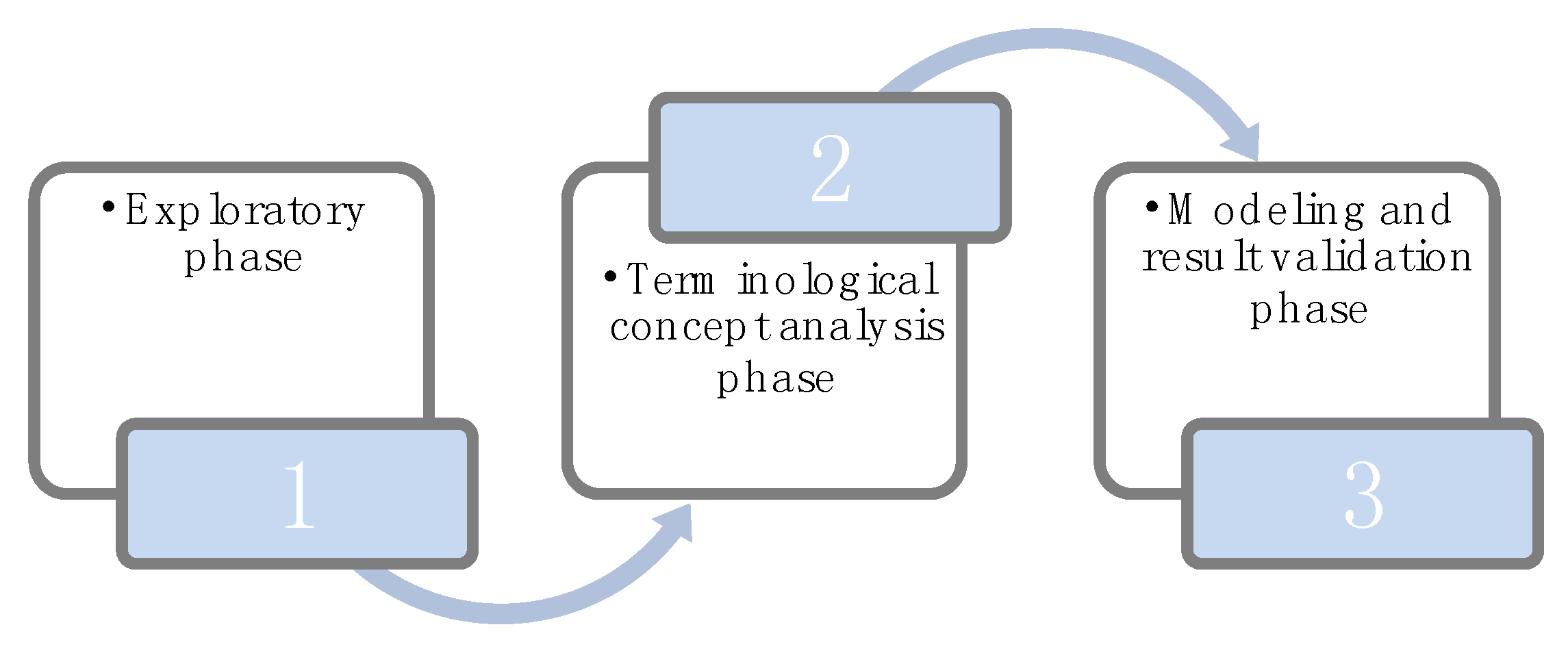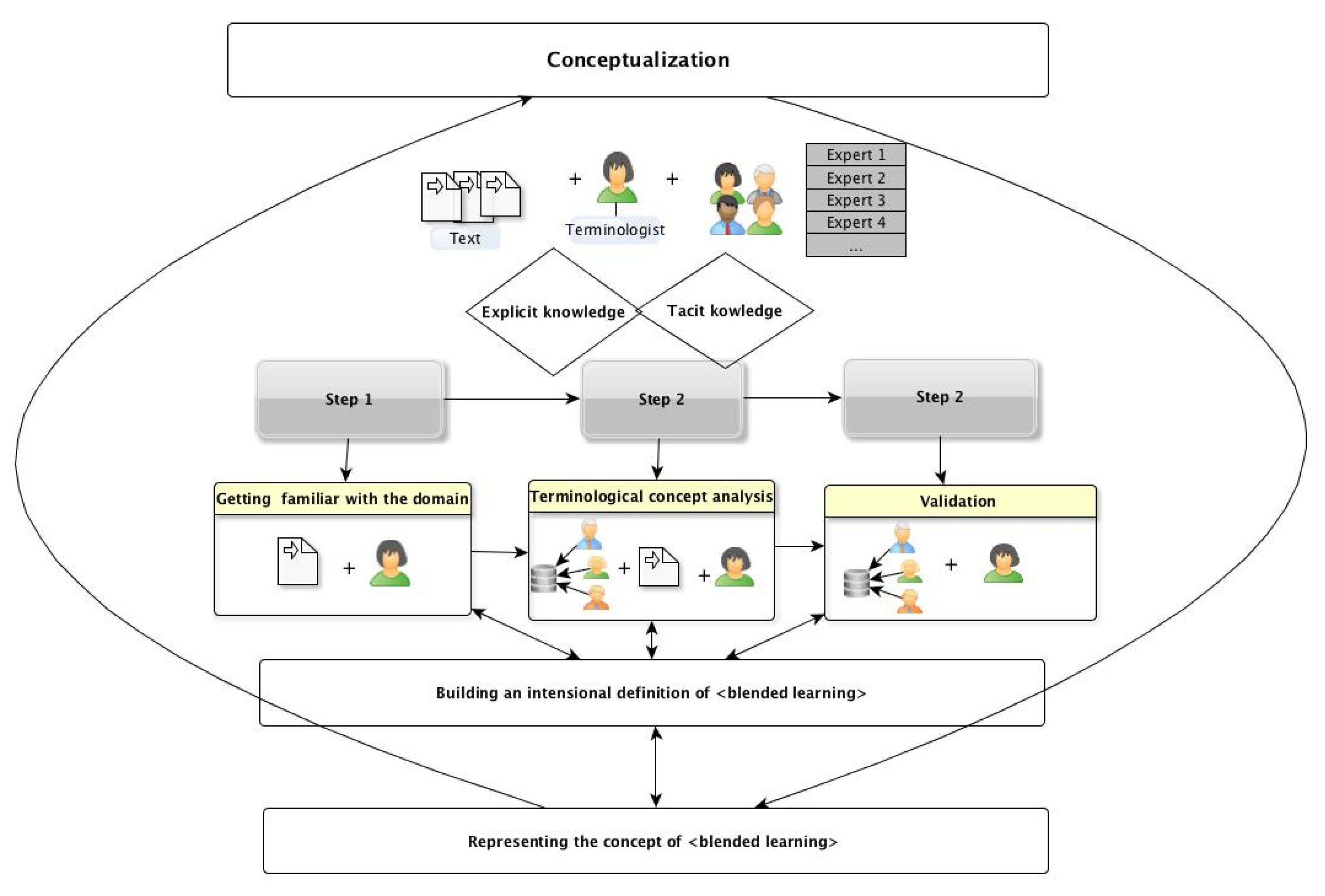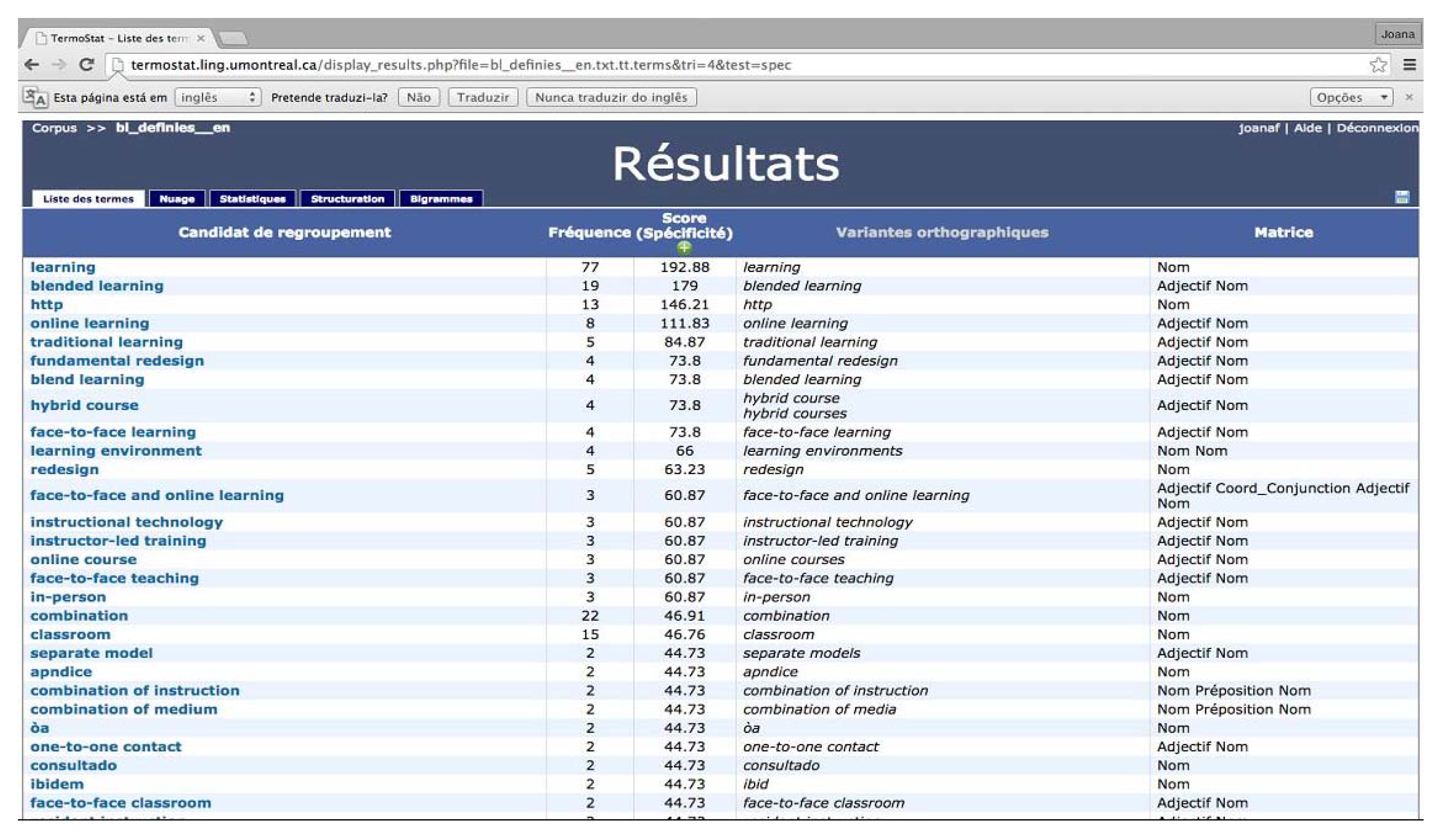2. Terminology and Concept Research
Natural language is a major tool to represent knowledge and knowledge develops in natural language. For such reason, no one will deny that contemporary Terminology is a powerful growing discipline, within the so-called knowledge society. By dealing with description, ordering and transfer of knowledge through language, Terminology emerges, according to Roche [
1] (p. 17), as a consistent body of theoretical and methodological frameworks that aim at answering a wide range of challenging problems related to
understand[ing]
the world, describe[ing]
the objects that populate it and find[ing]
the right words to talk about them. Among such problems, concept definition, along with concept description, are regarded as core issues in Terminology, as stated by Rey [
2] (p. 40). After all, conceptual precision and clarity are major prerequisites to all kinds of research areas, which emphasizes the role of Terminology as a linguistic and knowledge-related discipline rather oriented towards instrumental aims.
Defining or describing a concept by delimiting its characteristics (as well as being able to identify its exact position within a concept system) are ancient concerns, as Picht states [
3] (p. 7):
Generally speaking the need for terminology has existed for as long as we are able to find evidence of professional communication. Furthermore, as claimed by Hempel [
4] (p. 87):
Theory formation and term formation go hand in hand, neither can be carried out in isolation.In short, concepts, as elements of the structure of knowledge, emerge as an exciting but complex research object. Can they be directly found in language? Can one trust languages as analytical methods …
à l’aide desquelles nous procédons du connu à l’inconnu? As pointed out by Lavoisier [
5] (p. 357)? This study is framed by the epistemological view that Terminology has both a linguistic and a conceptual dimension, though it is claimed that an isomorphic relationship between language and knowledge cannot be taken for granted. This is the exact reason why one needs to specify the theoretical view that is encapsulated in the idea of a concept-based Terminology, whose primary aim is first to understand and then to name a given object. In other words, the foundational premise of a concept-based approach is that there is no one-to-one correspondence between atomic elements of knowledge and atomic elements of linguistic expression.
Following such view, a methodological approach to Terminology merely based upon specialized text research is regarded as biased. We are fully aware that as argued by Costa
et al. [
6] (p. 13):
The need for a conceptual organization has to do with the indispensability of moving away from linguistic manifestations to better encompass the concepts that exist regardless of language.As already stated, studying a concept implies challenging options. This paper aims at presenting the methodological model grounded in the premise that interactional strategies between terminologist and domain experts deserve particular research attention. To our mind, the key to concept-based terminological work is to carry out a concept analysis of data gathered from specialized text corpora combined with an elicitation process of the tacit knowledge and concept-oriented discursive negotiation. In this paper we share a path to understand, describe, delimit and define the concept of blended learning believing that, though it is a particular case study, it can allow for a certain level of generalization and replication for researchers interested in going deeply in the investigation of fuzzy and unclear concepts.
3. Contextualizing Blended Learning Fuzziness
The point of departure of this research was the perception that, though
blended learning is not exactly a new concept both in the North American and the European Higher Education scenarios, there is still a lack of precision when it comes to define what it means. Even though for North Americans, according to Norberg
et al. [
7],
blended learning is accepted as the
new normal in Higher Education, the authors believe that European educational researchers are missing something important about its relevance.
Everyone will agree with the broad understanding that
blended learning is a combination of traditional face-to-face learning with online learning. But does such of a minimalistic and straightforward description not carry the risk of simply promoting its adoption as an
easy take-way solution (Norberg & Jahnke, [
8]) often described as
the best of both worlds? We believe there is nothing wrong in perceiving
blended learning as a negotiable third way between the traditional education practices and a
pure e-learning option, but it seems vital to understand what is precisely at stake: A mere combination of two delivery modes with flexibility of time or place? A complex integration of pedagogical theories? A disruptive and transformational change in the teaching and learning processes? Despite the growing interest in discussing such views, academic research on the
blended learning model still shows a huge disconnection between the empirical and the theoretical studies, the first being much more pervasive (Drysdale
et al. [
9]).
Besides, shifting terminology reinforces the idea that there is a lack of homogeneity at least at the designation level: both in English and in Portuguese one can find different alternatives, such as blended/mixed/hybrid/flexible or blended/misto/combinado/híbrido to name this design and delivery model.
We carried out a literature review in these two languages, comprising the time span between 2002 and 2014, together with interviews to domain experts and these procedures allowed us to obtain corpora of descriptions and definitions (both in English and in Portuguese), showing that in the Higher Education landscape there are many competing perceptions of blended learning that, despite their apparent singularity, reduce blended learning to the broad understanding of mixing face-to-face activities with online interaction. In the same fashion, within the Portuguese Higher Education context blended learning is also perceived as a nebulous combination of face-to-face and online instruction.
Corpora gathered and scrutinized have also shown that as Picht & Draskau point out, [
3] (p. 62):
... a concept may not be viewed as an isolated unit in terminology. In this fashion, literature review and elicitation of data gathered through exploratory interviews to practitioners and domain experts, allowed us to find out that, as far as Higher Education delivery modes are concerned, there is a fuzzy spectrum of modes and models whose exact place has not yet been fixed within the
continuum presence/distance. As a matter of fact, different types of delivery modes, such as
e-learning, blended learning, online learning, technology enhanced learning, web-facilitated learning, hybrid learning, face-to-face learning show a certain degree of overlap and tend to be interchanged within the Higher Education context, as reported by Moore
et al. [
10] (p. 129). Their research identified the existence of a fuzzy conceptual space when they put forward the question: e
-learning, online learning, and distance learning environments: Are they the same? Their research pointed out that terms and the concepts that underlie them were often interchanged without meaningful and consistent definitions. According to them, practitioners and researchers need to agree on common definitions and terms. Obviously this lack of agreement makes it difficult to perform accurate cross-study comparisons. To solve such an overlap some authors and institutions believe that defining a percentage criterion can be a straightforward solution to delimit the concepts integrating the spectrum of delivery modes. For instance, according to Allen
et al. [
11] (p. 5),
blended learning implies that between 30 and 79% of the program content is delivered online. However, even the idea of percentage lacks consensus. To give an example, Smith & Kurten [
12] (p. 460), propose different percentages: Online activities must cover less than 45% of time. Furthermore, their categorization implies a distinction between
hybrid and
blended learning, which seems a peculiar differentiation.
As we can see, the
blended learning concept itself seems to exist in a
continuum of minimal online learning and minimal face-to-face learning. If we analyse the problem at an institutional level there is indeed a lack of transparency and regulation. But no matter the relevance of dimensions that have been discussed, as it will be shown in coming sections,
blended learning is fundamentally, as
Garrison & Vaughan [
13] remark, a
transformational redesign of teaching and learning and such a view must be encapsulated in its definition.
4. Towards a Concept-based Approach
Getting back to methodology, Terminology offers different possibilities when it comes to selecting design and methods to carry out terminological work. No matter what options are taken, specialized knowledge, as we have just demonstrated, whether obtained verbally or textually, is rarely presented as precisely as terminologists would enjoy: conceptual and terminological fuzziness tend to occur. In our particular case, in order to study the
blended learning concept and propose an intensional definition, one stating its superordinate concept and naming the delimiting characteristics (Kockaert & Steurs [
14]), we embraced a mixed methodology as an overall strategy. Such a method has been largely implemented by Costa ([
6]
et passim), and entails the recognition that though specialized text is a very important source for gathering empirical evidence, it is not a faithful mirror of a given conceptualization. In a similar fashion, as Nuopponen pointed out [
15] (p. 3), texts are relevant resources when it comes to performing a concept analysis, however, when describing a given material or immaterial object and its relationships with other objects, they often produce presuppositions and entailments that correspond to tacit knowledge that may not always be easy for the terminologist to infer.
Thus, a mixed methodology sets the possibility of combining text and discourse analysis with concept analysis. The immediate advantage is that it allows for triangulation of the data collection. As Costa [
16] (p. 9) states:
We start off with the text, in order to, through it, process, organize and represent knowledge, that is to say that we distance ourselves from the text, so as to come back to it later on in our workflow.In short, a mixed methodology implies a cyclical, iterative, recursive procedure managed by the terminologist who establishes the set of planned interactions with specialised text and the domain expert (see
Figure 1):
According to the ISO/FDIS 704 standard [
17] (p. 5), terminology work must fundamentally focus on
a clarification and standardization of concepts and terminology for communication between humans. Nonetheless, within the academic community, the understanding of the terminologist
praxis and epistemological status is not always a matter consensus. Depecker materialized such a controversy during the
Disputatio of TOTh Conference (
http://www.porphyre.org/), by wondering whether the terminologist is an heir of Saussure or Aristotle. In our opinion, s/he definitely is both. If Terminology as theory has a double dimension—linguistic and conceptual—as Costa & Roche [
18] (p. 1) clearly explain, the terminologist inherits these two theoretical backgrounds:
Les terminologues jouent donc un rôle central dans toute activité professionnelle où les compétences discursives, le transfert et l’organisation de connaissances sont requis.In brief, in our study, when performing the role of terminologist we tried to combine evidence gathered from text and to elicit knowledge from experts by grasping hidden assumptions and clearly identify areas of consensus, correspondence, conflict and contrast, as proposed by Shaw & Gaines [
19]. Interactional strategies were regarded as mechanisms selected or conceived by the terminologist to elicit, discuss and negotiate tacit knowledge and allowing for the construction of an intersubjective representation of the object-domain being studied. As Costa
et al. [
6] (p. 7) show, there is a very desirable symbiosis between domain expert and terminologist (see
Table 1):
In accordance with the proposal stated in the table, we hold the view that it is important to develop an action-reflection procedure, both introspective and collaborative, in which the terminologist will become a conceptualizer, a decision-maker and an interventionist, as it will be shown in the following section.
5. Researching and Defining the Concept of Blended Learning: A Methodology
Taking the above into consideration, researching and defining
blended learning was a long, intensive but thrilling academic challenge, in great measure possible thanks to the effort spent in building a methodological model to shape the whole process—three major phases were predicted: (1) an exploratory phase in the area/ object of the study; (2) a conceptual analysis phase of discourse and textual empirical data; and (3) a modeling and result validation phase (see
Figure 2):
The workflow now represented with more detail combined different strategies that led to the ultimate
blended learning definition, which intends to be a faithful representative of the diachronic inheritance and that simultaneously improves the accuracy of the concept. As schematically expressed in
Figure 3, the terminologist interacted in a cyclical and iterative fashion with text and domain experts, eliciting and negotiating tacit and explicit knowledge:
The exploratory phase was regarded as the starting point, having the goal of identifying all sorts of evidence, in other words, obtaining a primary decoding of reality. This approach gets close to phenomenology and grounded theory that are based on collecting views from a number of participants in order to describe what they have in common. (Creswell
et al [
20] (p. 252)). Among other strategies, a questionnaire was conducted in order to grasp Higher Education practitioners perceptions, particularly concerning distinctions between
e-learning and
blended learning and
blended learning and
distance education. Other empirical data used in this phase included a collection of individual interviews conducted with Portuguese domain experts.
Furthermore, a literature review process was also carried out in order to identify possible shifting terms that represent the blended learning concept (for instance, formação combinada, ensino semi-presencial, ensino combinado, formação mista, metodologia de formação mista, aprendizagem híbrida, modelo combinado, b-learning, blended learning, hybrid learning, among others). This review was performed by carrying out an exhaustive analysis of works published between 2002 and 2014. The text corpora gathered include authorial and institutional perspectives both in English and in Portuguese. Major aims of this phase were: (a) to establish explicit correlations between blended learning and the Post-Bologna scenario; (b) to identify the spectrum of delivery modes that range from entire face-to face interaction mode, to a distance mode (traditional, web-enhanced, web-facilitated, blended, hybrid, fully online); (c) to contextualize blended learning according to a diachronic approach; (d) to discover candidate characteristics of the concept that deny the dualist perception of blended learning as a mere combination of classroom learning and e-learning; (e) to discuss the contribution of a blended learning definition to quality standards, as far as Higher Education is concerned.
The second phase - terminological concept analysis—implied the amplification of the elicited knowledge, by using a panel of domain experts who were individually interviewed by means of a common protocol. Interviews were subsequently transcribed and scrutinized (see
Table 2):
A semi-structured interview script was produced with eight questions that helped conduct the interactions and compare and contrast perceptions obtained. Answers provided to questions 1, 2, 3 and 6 were particularly relevant to identify possible candidate characteristics and to predict their level of distinctiveness (see
Table 3):
Questions 1, 2 and 6 were particularly useful. The first question aimed at distinguishing between
blended learning and
e-learning; the second focussed on grasping an extensional definition, the third one was related to delimit the concept within the higher education landscape and the sixth was meant to extract possible candidate characteristics. This way, interviews were part of text corpora that allowed to identify knowledge rich contexts in the form of descriptions, definitions and defining contexts of
blended learning and were subject to semi-automatic extraction of forms useful to differentiate between essential and accidental characteristic candidates, that is, those that seemed to be indispensable to understanding a concept and those that seemed too broad (see
Figure 4):
Seventeen candidate characteristics emerged from the fruitful process of combining text analysis with oral data analysis, as listed in
Table 4. A detailed process of registering linguistic markers in English and Portuguese allowed for a very fine-grained perception of the degree of occurrence of characteristics and a deep understanding of the meaning behind designations:
Each of the characteristics listed above was discussed and analysed in detail, by comparing and contrasting existing views and by extracting a possible common understanding of the underlying meanings. After concluding this extensive analysis and synthesis process, we felt the requirements of the two phases had been fully accomplished. So, with regard to the third phase—modeling and validation a definition
—the work was structured by an action-research procedure during which four cycles were conceived to favour the cyclical and iterative process of proposing, getting feedback, reconceptualising, redrafting, and so forth. The ultimate step—validation—comprised the strategy of using a focus group of domain specialists other than the ones previously consulted (see
Table 5):
As explained, after concluding the identification of blended learning genus (generic concept) and differentia (essential features), by assessing the relevance of the candidate characteristics, the linguistic challenge of drafting a definition and description took place. This interactional process was particularly thrilling and detailed, implying a continuous decision-making process that would have been impossible without the comfort provided by the deep research conducted beforehand. This sequence of cycles was supported by detailed grids designed to compare and evaluate the degree of agreement or disagreement with the definition proposed. By the end of the process we got the very satisfactory impression of having accomplished this huge task of encompassing in few words a complex of studied, shared and negotiated analytical judgments.
6. The Outcomes of the Research: Blended Learning Negotiated and Defined
As already stated, distinguishing between what is essential and inessential was a major task in the process of proposing a definition, for we subscribe Rickert’s view [
21] (p. 232), according to whom only a part of the world is relevant for concept formation. For such a reason, the process of progressive refinement of characteristics was itself very defying. We kept in mind that, according to ISO /FDIS 1087-1 (2000: 3.2.4) [
22] standard, a concept is a
unit of knowledge created by a unique combination of characteristics and a characteristic is an essential feature
indispensable to understanding a concept. Interviews definitely made choices easier, as it can be seen in the table content (
Table 6):
Having reached an extended understanding and a satisfactory level of consensus, we started cycle 1 and sent to the national expert involved three alternatives of a
blended learning definition with slight differences of content and expression (see
Table 7):
At this stage, there was a very fine-grained co-analysis and negotiation of the three proposals, so, each characteristic was deeply explained and re-evaluated. Proposals were assessed within a scale (8–10 representing the higher score and 0–4 being the worst). The three proposals were subsumed to a single one and two scripts were designed to conduct follow-up interviews and a focus group.
As for the second cycle, three international domain experts were invited to take part of the modeling and validation process, by expressing their personal views concerning the essential nature of the characteristics selected to be linguistically represented through the definition. Some interesting considerations were brought to discussion. Overall, there was a broad consensus concerning the content proposed, but there were different views, to quote some examples, about the choice between
model and
paradigm, or the identification of the generic concept that entails
blended learning:
distance education and
online learning, or
e-learning were considered (see
Table 8).
After scrutinizing the outputs of this cycle, some suggestions were incorporated and the definition content was reorganized and redrafted (see
Example 1):
The validation process—here understood as a group of close interactions between terminologist and domain expert intending to reach a consensus about the options comprised by a given conceptualization—took place in the third cycle in order to go deeper with the definition harmonization. By promoting a focus group discussion to carry out the ongoing process of collective thinking, experts were invited to express their opinion about the general content of the definition and then assessed each of the characteristics put forward (see
Table 9):
The output obtained made it possible to outline different concept maps that followed different evolution stages of the concept definition negotiation process and helped clarify concept relations that underlie it. Such a visualization strategy was used as a technique to explicit the definition content and when it comes to experts it makes it easy
to see beyond words. They were sent together with the validation grid to experts who participated in the fourth cycle. Perceptions and suggestions were carefully analyzed and, once again, the output of the cycle led to some decisions. After assessing different suggestions concerning the relevance and the order of the essential characteristics, we came up with the final linguistic output: an intensional definition which specifies the
genus (distance education) and a
differentia set up by eight traits aiming at being truly distinctive (see
Example 2):
As we can see, the approach suggested here truly benefited from a meaningful dialogic interaction between terminologist and domain experts. As Rickert states:
The truth does not lie in a discovery by an individual, but truth is what these discoveries have in common, and the way to establish truth is to determine what is agreed among the many different opinions. ([
21] (pp. 203–204).
7. Concluding Remarks
With this study we have engaged in contributing to harmonize the definition of a concept that seems to encompass a major trend in the present and near future Post-Bologna Higher Education landscape. It was shown that understanding, analyzing and defining a concept implies working with Terminology theoretical and methodological frameworks. Thus, through
blended learning we tried to demonstrate that definition work involves a set of logical as well as linguistic operations that result in the production of a string of natural language which is expected to accommodate the density of inherited and shared knowledge (Rey, [
2] (p. 41)).
We also believe the macrostructure of arguments put forward in this paper clearly shows that the process and the outcomes of this work were regarded as equally relevant. As Ziman [
23] (p. 27) states
science is more than personal knowledge. To achieve the ultimate goal of consensuality science must be capable of expression in an unambiguous public language. This way, a mixed methodology as designed by Costa ([
16]
et passim) revealed a very resourceful framework for encouraging a challenging combination between specialized text and expert knowledge.
Our interpretative analysis focused on understanding and categorizing already existing blended learning definitions, available in different sources and scrutinizing them in terms of genus and differentia (accidental and essential characteristics). Such an option goes deep into already existing knowledge and aims at improving it, by adding new insights into it. As for blended learning, the need to improve the accuracy in Portuguese Higher Education landscape proved to be very fruitful, because researchers and practitioners who contributed to the definition fully recognized that the importance of an unambiguous public language concerning this domain will not restrict freedom of thought. Inversely, they deeply agree that definitions are themselves the basis for transparency in public and insightful debate.











